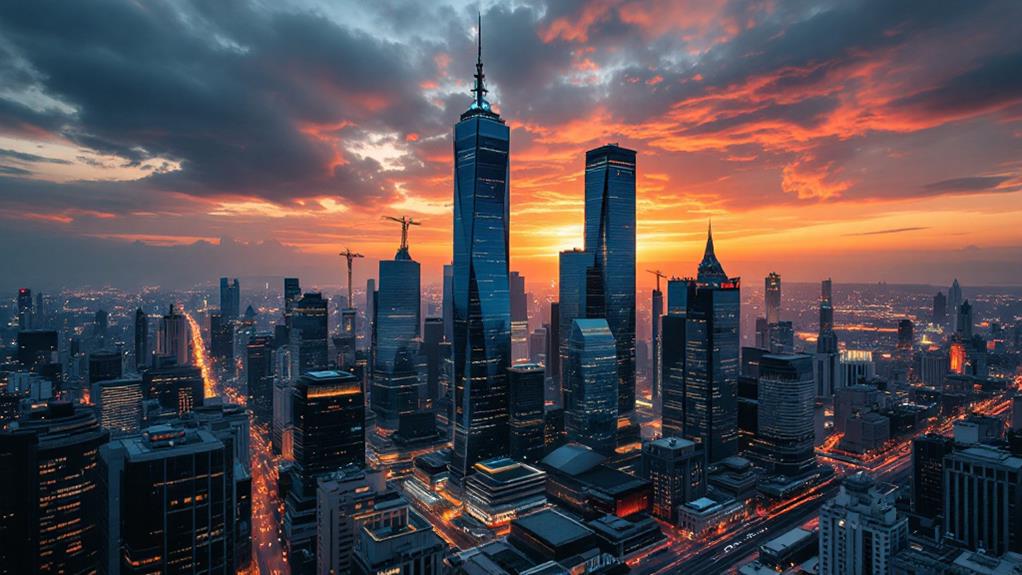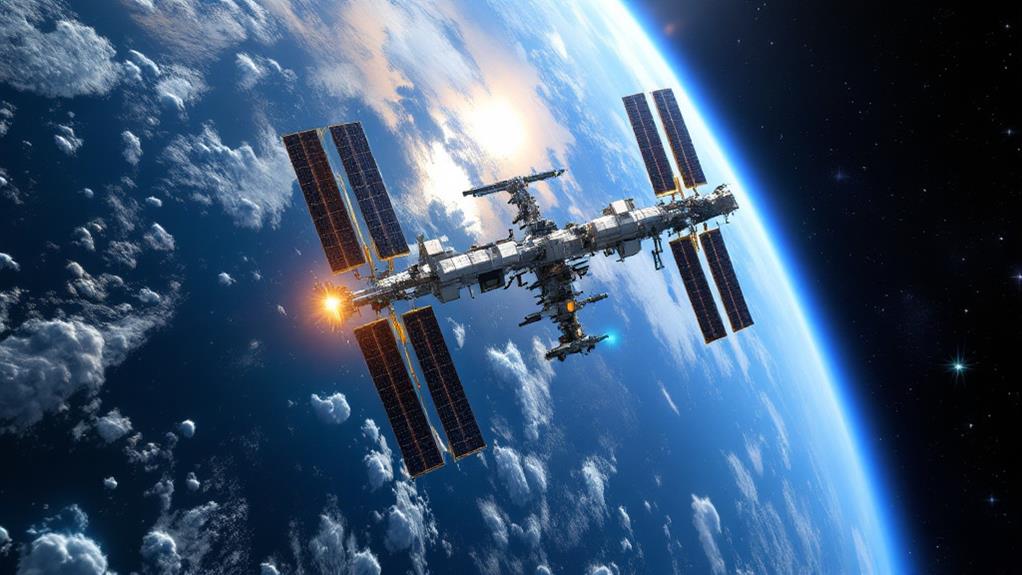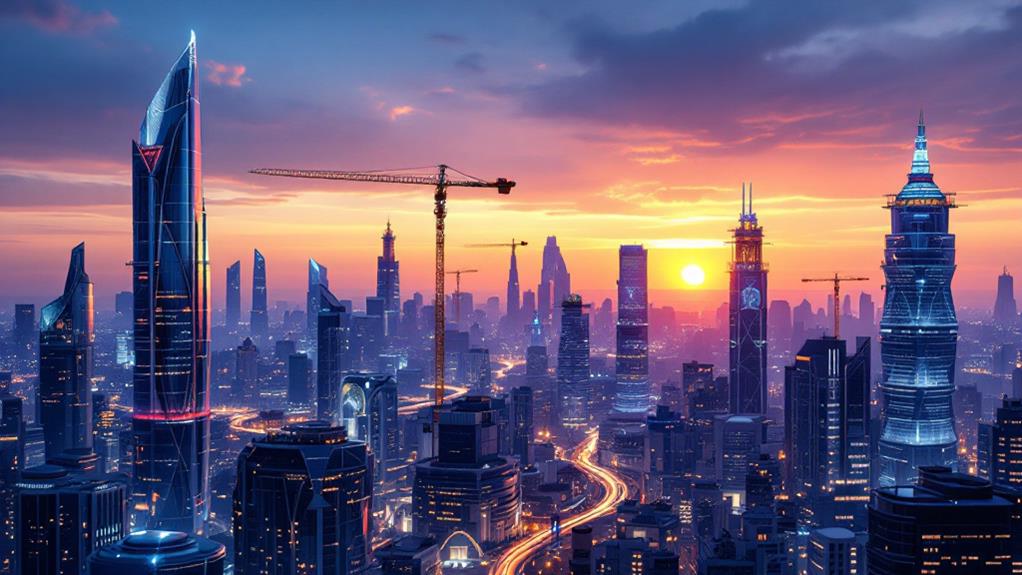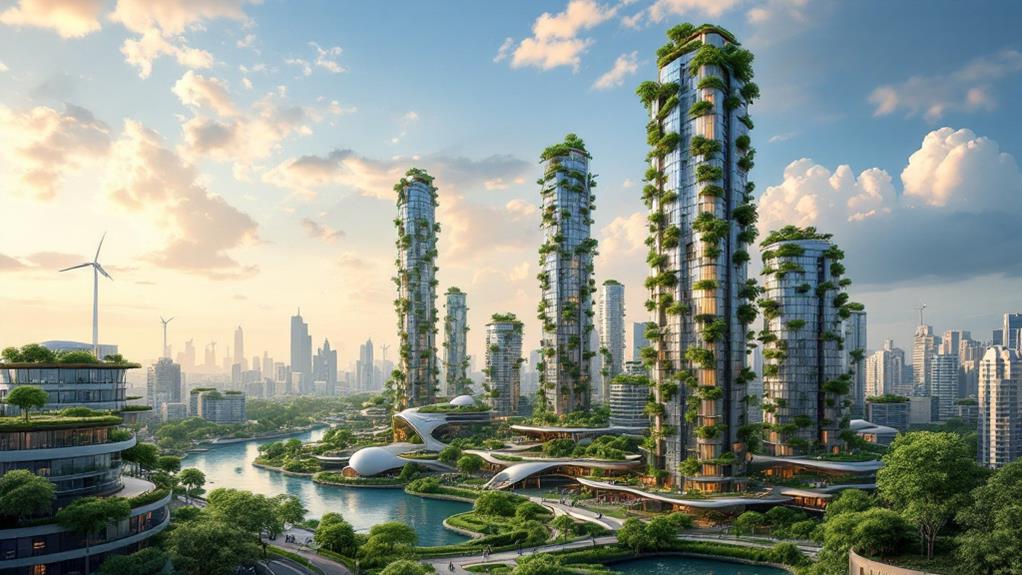Largest Building Projects of the 21st Century: Transforming Skylines

You're witnessing the incredible transformation of skylines worldwide through monumental 21st-century building projects. NEOM City Vision in Saudi Arabia, fueled by $500 billion, promises zero-carbon emissions and runs on renewable energy. The Belt and Road Initiative, costing up to $8 trillion, enhances global trade and infrastructure across over 140 countries. The International Space Station, a $150 billion marvel, advances scientific research through international collaboration. Closer to home, cities like Toronto and Shenzhen lead in skyscraper developments, integrating sustainable practices. As urban landscapes evolve, they reflect a blend of innovation, sustainability, and economic ambition that might inspire curious minds.
NEOM City Vision
In Saudi Arabia, NEOM City stands as a pioneering project that exemplifies futuristic urban development. Spanning 26,500 square kilometers and backed by an investment of around $500 billion, NEOM City is a visionary initiative under the ambitious Vision 2030. This project aims to diversify the economy, reducing the nation's dependency on oil revenues, and positioning Saudi Arabia as a global hub for creativity and sustainability.
At the heart of NEOM City lies The Line, a revolutionary linear development designed to improve walkability and eliminate carbon emissions by excluding cars and streets. This cutting-edge approach integrates advanced technology and AI, ensuring the city operates efficiently and sustainably. NEOM City is set to be entirely powered by renewable energy sources, showcasing a commitment to environmental sustainability and economic diversification.
The Belt and Road Initiative
While NEOM City redefines urban development in Saudi Arabia, China's Belt and Road Initiative (BRI) represents a monumental effort in global infrastructure expansion. Launched in 2013, this ambitious infrastructure strategy aims to improve global connectivity by building a vast network of railways, roads, pipelines, and ports across Asia, Africa, and Europe. With an estimated cost between $4 trillion and $8 trillion, the BRI involves over 140 participating countries, promoting international trade, economic growth, and cultural exchange.
Here's what you should know about the Belt and Road Initiative:
- Economic Growth: By facilitating smoother trade routes, the BRI increases economic growth for participating countries, opening new markets and opportunities.
- Construction Projects: Major developments like the China-Pakistan Economic Corridor and the Mombasa-Nairobi Railway in Kenya exemplify the BRI's transformative construction projects.
- Debt Dependency: Critics warn about potential debt dependency, as many countries may struggle to repay large loans, leading to financial instability.
- Environmental Impacts: Large-scale construction projects can lead to significant environmental impacts, raising concerns about sustainability and ecological damage.
The Belt and Road Initiative aims to reshape international trade and foster cultural exchange. However, it's important to evaluate the potential drawbacks like debt dependency and environmental challenges.
International Space Station Collaboration

How does the International Space Station (ISS) exemplify global collaboration? The ISS stands as an illustration of what international teamwork can achieve in the domain of space exploration. Five major space agencies—NASA, Roscosmos, JAXA, ESA, and CSA—joined forces to create this scientific marvel orbiting 400 kilometers above Earth. It's more than just a project; it's a symbol of unity, pooling resources and expertise from around the world.
This collaboration has led to significant advancements in space technology. The ISS, continuously inhabited since November 2000, functions as a microgravity and space environment research laboratory. It supports diverse scientific research in biology, physics, astronomy, and more, offering opportunities that Earth's environment can't provide. For instance, the unique conditions aboard the ISS allow astronauts to study human biology in ways that improve our understanding of health and disease.
The ISS's impressive $150 billion cost reflects its importance as one of the largest international scientific endeavors. With over 240 astronauts from 19 countries visiting, the ISS serves as a global platform for sharing knowledge and fostering relationships. It exemplifies how international collaboration can push the boundaries of what's possible in space and science.
South-North Water Transfer
Amid China's pressing water scarcity, the South-North Water Transfer Project stands as a monumental effort to address this vital issue. This ambitious project aims to divert water from the Yangtze River to the dry northern regions, tackling the severe shortages these areas face. With a staggering estimated cost of $80 billion, the project's construction includes three major canals and numerous tunnels, forming an extensive network of infrastructure. Once completed, it will deliver approximately 44.8 billion cubic meters of water annually, transforming the lives of countless northern communities.
However, the project isn't without its challenges. These include:
- Environmental Concerns: The diversion of water has sparked fears about ecological impacts on both the Yangtze River and the regions it supplies.
- Displacement: As construction progresses, many communities face relocation, stirring social and economic disruptions.
- Engineering Complexity: The sheer scale and technical demands of the infrastructure require cutting-edge solutions and careful planning.
- Cost Management: With such a high price tag, efficient budget use is essential to guarantee the project's success without financial overruns.
Despite these hurdles, the South-North Water Transfer Project reflects China's determination to resolve its water scarcity issues through creative and large-scale water management strategies.
Global Skyscraper Developments

Addressing water scarcity is just one of the many engineering marvels of this century. Another transformative feat is the unprecedented boom in global skyscraper developments. Take Toronto, where the skyline is rapidly evolving with 30 skyscraper projects under construction. Among these, "The One" will soon rise to 306 meters, marking it as the city's tallest structure. Toronto's skyline is not just about height but also about its economic significance, driven by these ambitious construction endeavors.
Across the globe, Shenzhen is setting new benchmarks with 80 skyscrapers under construction, including 11 supertall towers. This surpasses the entire U.S. total, showcasing Shenzhen's rapid urbanisation and its role as a global economic powerhouse. Meanwhile, in Melbourne, the skyline is reaching new heights with 23 skyscrapers underway, including the Green Spine project, destined to be Australia's tallest building at 354 meters.
Even Europe isn't left behind. London's skyline has seen dramatic changes, with 17 skyscrapers over 150 meters currently reshaping the city. Ultimately, in Africa, Lagos's Eko Atlantic project is transforming its skyline, positioning it as a commercial gateway, reflecting the continent's rising vertical developments. These projects illustrate the dynamic nature of our urban landscapes.
Emerging Architectural Innovations
In the domain of emerging architectural innovations, skyscrapers are undergoing a revolution that marries functionality with sustainability. This skyscraper boom is characterized by the fusion of cutting-edge technology and eco-friendly practices. The Jeddah Tower aims to become the tallest building in the world, showcasing advanced vertical construction techniques and pushing architectural boundaries. Dubai Creek Tower follows suit, further emphasizing the region's commitment to height and innovation.
- Sustainable Practices: New skyscrapers prioritize sustainable practices by integrating green building certifications like LEED, ensuring that energy-efficient materials are used throughout the construction process.
- Smart Building Technologies: These technologies are transforming how skyscrapers manage energy, enhancing environmental performance by optimizing resource use in real-time.
- Unique Designs: Architectural innovations bring unique designs to life, incorporating elements like vertical gardens and renewable energy integration, which are vital to eco-friendly urban development.
- Vertical Construction Techniques: As buildings soar higher, these techniques are fundamental, allowing architects to achieve unprecedented heights while maintaining structural integrity.
Sustainable Urban Practices

As cities continue to expand, the need for sustainable urban practices becomes increasingly critical. You're seeing more and more skyscrapers integrating renewable energy sources, a move that's quickly becoming the norm. These designs aim for LEED and BREEAM certifications, ensuring that sustainability is at the forefront. Urban greenery and vertical gardens are now common features, enhancing biodiversity and improving air quality. This isn't just about aesthetics; it's about making cities healthier and more livable.
Smart building technologies are playing a significant role in reducing energy consumption. By utilizing energy-efficient materials and systems, these technologies minimize the environmental impact of new constructions. Mixed-use developments are also gaining traction, promoting community engagement and the adaptive reuse of historical buildings. This approach not only preserves cultural heritage but also revitalizes urban areas in a sustainable manner.
As urbanization rates climb, the demand for high-rise living is prompting cities to adopt these sustainable practices. It's not just about accommodating growing populations; it's about doing so responsibly. By focusing on these strategies, you're not merely transforming skylines—you're paving the way for a more sustainable urban future.



